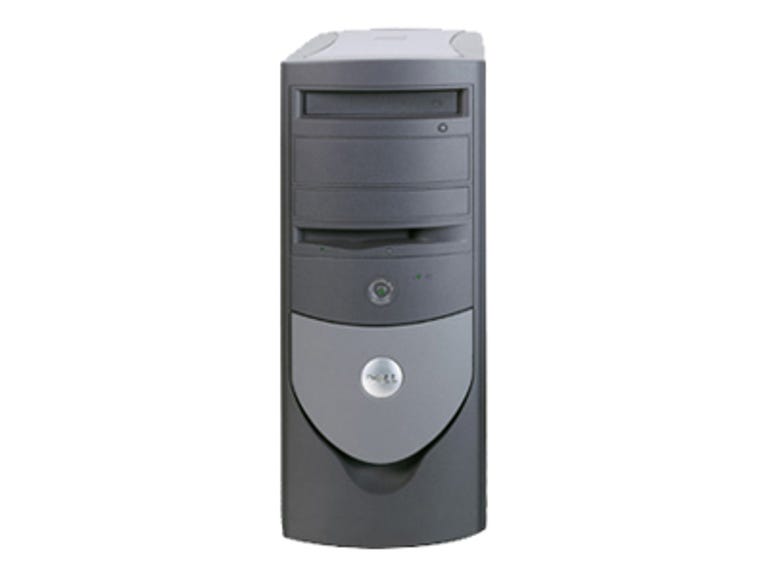 Why You Can Trust CNET
Why You Can Trust CNET Dell OptiPlex GX280 review: Dell OptiPlex GX280
More than enough PC for most offices, the Dell OptiPlex GX280 offers the latest in new desktop technology from Intel. The boring case won't make an impression, but you'll quickly forget about appearances once you see how quickly this PC works. Read our review for more detail.
Whether your operation has 10 seats or 10,000, the staid $1,731 Dell OptiPlex GX280 delivers plenty of what your office needs: simple, straightforward functionality backed by rock-solid service and support. We've seen this hinged case in a number of Dell Dimension PCs, and we maintain our criticism of its cumbersome design. But if you can put up with a cranky IT staff (or if you don't mind getting down and dirty yourself), the OptiPlex GX280 and its high-end configuration will serve your office ably for many years.
The Good
The Bad
The Bottom Line
Design-wise, the OptiPlex GX280 is a bit of an eyesore and a pain to get inside. The gray case accents don't exactly match the silver accents of the peripherals, and while the venerable clamshell chassis is tool-less, you need to press buttons on both the top and the underside of the case to open it--remarkably inconvenient if you store the case on the floor. We will concede that the design allows for easier access to the drive bays and the expansion card slots than many removable side-panel cases, however.
Should you decide to expand the OptiPlex GX280, you'll find plenty of interior room. With three available PCI slots, two additional memory slots, an x1 PCI Express slot, three 3.5-inch bays, and a single 5.25-inch bay, you're given vast potential for adding more storage, memory, or features via an expansion card. Rear ports include six USB connectors and only a digital video port for hooking up compatible monitors (the system does ship with a DVI-to-analog dongle for use with legacy displays). Up front, you'll find two conveniently placed USB ports and a headphone connector. You can also opt for the OptiPlex GX280 in other flavors: a small desktop chassis of the old-school horizontal orientation or a small-form-factor case that takes up little desk space but offers scant room for expansion.
Ironically, the Dell OptiPlex GX280's restrained, unaccented plastic exterior houses the very latest in desktop technology. Inside the system, you'll find a brand-new 3.2GHz Intel Pentium 4 540 processor paired with Intel's new 915G chipset. As evidenced by its outstanding score on our SysMark 2004 test (186, compared to the performance-leading MPC ClientPro 545's 188), this configuration will serve you extremely well on current applications. Coupled with 512MB of new 400MHz DDR2 RAM and a 160GB Serial ATA hard drive, we speculate that the OptiPlex GX280 will provide enough horsepower to run most work-related software, even if system requirements for applications such as Microsoft Office and other programs climb significantly.
We should point out that the OptiPlex GX280 is not fit for intense gaming. Its only option for a 3D card is the 64MB ATI Radeon X300 64MB. With this low-end card, the OptiPlex GX280 scored a respectable 57.2 frames per second (fps) on our Unreal Tournament 2003 test, but you can figure that the system can't achieve the 60fps sweet spot on an older game, so playing more-current titles such as Doom 3 is really not an option. However, the 17-inch Dell UltraSharp 1703FP will do justice to just about anything you'd care to display on it, a good thing considering the CD-RW/DVD combo drive. You'll need to provide speakers; this configuration doesn't include them.
The ever-present security specter looms heavily over any PC purchase but especially over business-class systems. If you've been following the release of Windows Service Pack 2, you know that Microsoft released a number of security-minded improvements in the OS update, including SP2's new data execution prevention feature (DEP). This feature protects systems against buffer-overrun attacks from Sasser-like code. If you're considering an Intel-based purchase like this one, you'd be wise to note that, at press time, only systems using AMD processors can take advantage of this fix; DEP won't work on Intel-based boxes. Whether Intel is able to address the problem remains to be seen, but until it does, companies looking for maximum security should keep this limitation in mind.
Dell offers several productivity suites and a bevy of third-party applications for purchase along with the OptiPlex GX280, but our system shipped with only Dell's ImageWatch and OpenManage system administration software. Service and support options are incredibly thorough, as per Dell's norm, with extensive documentation and a three-year parts-and-labor warranty.
| SysMark 2004 office-productivity rating | SysMark 2004 Internet-content-creation rating | BAPCo SysMark 2004 rating |
| Unreal Tournament 2003 Flyby-Antalus 1,024x768 |
System configurations:
Dell OptiPlex GX280
Windows XP Professional; 3.2GHz Intel P4 540; Intel 915G chipset; 512MB DDR2 SDRAM 400MHz; 64MB ATI X300 (PCIe); Seagate ST3160023AS 160GB Serial ATA 7,200rpm
Dell OptiPlex SX280
Windows XP Professional; 3.2GHz Intel P4 540; Intel 915G chipset; 512MB DDR2 SDRAM 400MHz; 128MB integrated Intel 915G (shared memory); Seagate ST3160023AS 160GB Serial ATA 7,200rpm
HP Compaq Business Desktop dc7100
Windows XP Professional; 3.2GHz Intel P4 540; Intel 915G chipset; 512MB DDR SDRAM 400MHz; 128MB integrated Intel 915G (shared memory); Seagate ST380013AS 80GB Serial ATA 7,200rpm
HP Pavilion a650e
Windows XP Professional; 2.4GHz AMD Athlon 64 3700+ (Socket 754); Nvidia Nforce-3 chipset; 1,024MB DDR SDRAM 400MHz; 256MB ATI Radeon 9800 (AGP); WDC WD2500BB-22FTA0 250GB 7,200rpm
Sony VAIO PCV-RS630G
Windows XP Home; 3.2GHz Intel P4; Intel 865PE chipset; 512MB DDR SDRAM 400MHz; 128MB ATI Radeon 9200 (AGP); WDC WD2500BB-98FTA0 250GB 7,200rpm
